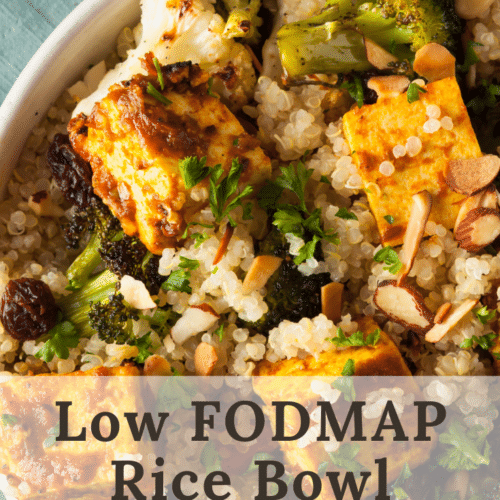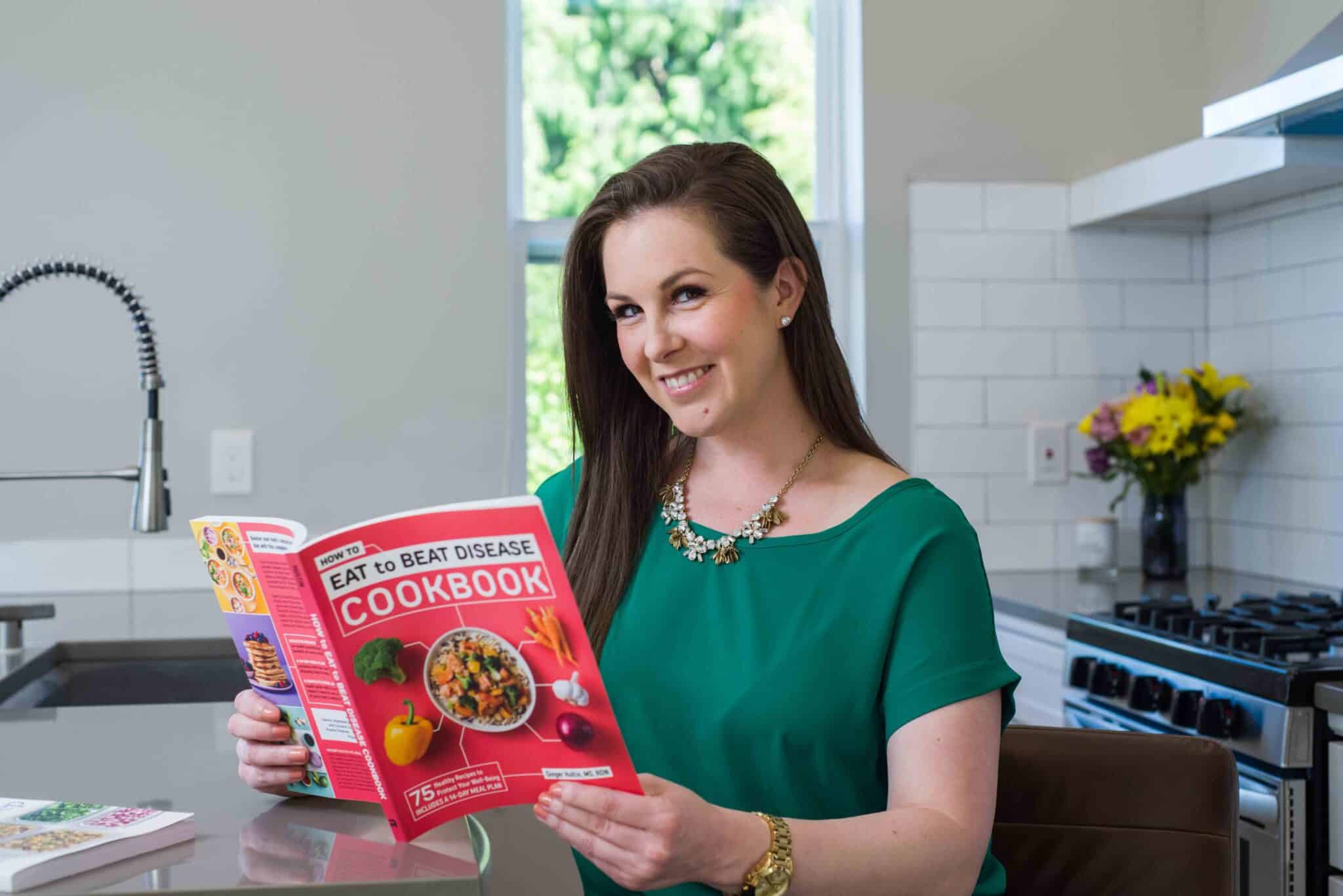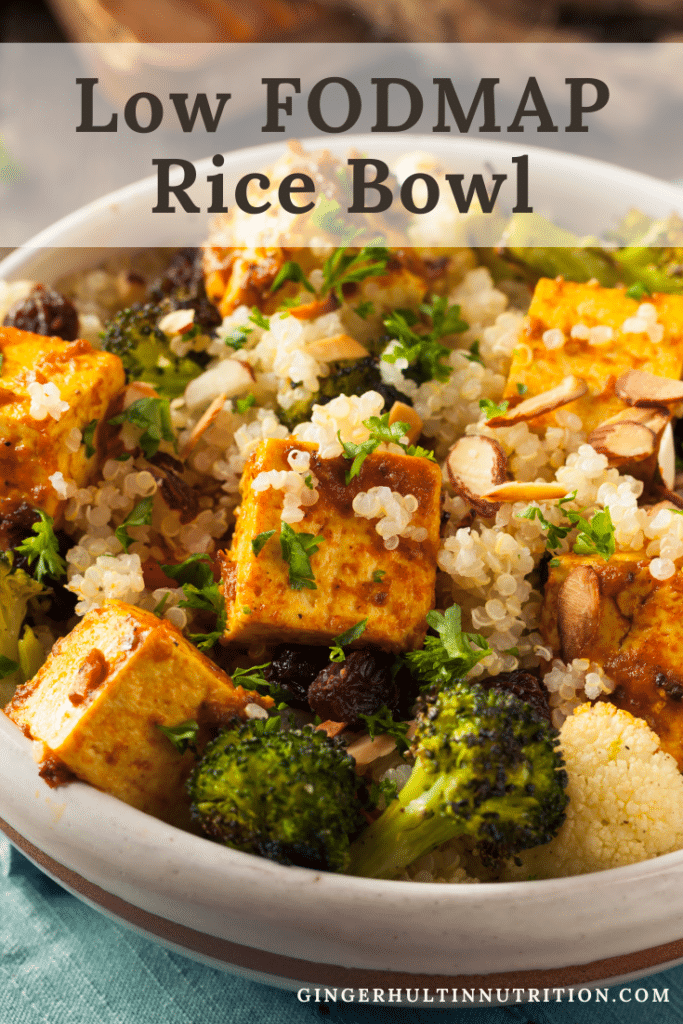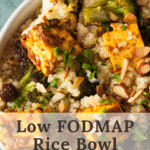Low FODMAP Rice Bowl
December 30, 2023 by Ginger Hultin MS RDN
Bloating, pain, and unpredictable bowel movements – these are unfortunate companions for many individuals living with Irritable Bowel Syndrome (IBS) or small intestinal bacterial overgrowth (SIBO). While managing these chronic conditions can be challenging, the low FODMAP diet offers a promising path to relief and a healthier gut as you seek treatment for any underlying conditions. And that’s key – you really need to have an open-minded, collaborative doctor as well as a registered dietitian on your team to tackle these complex conditions. Though the low FODMAP diet can be really confusing, I have lots of advice for you as well as a delicious, easy low FODMAP rice bowl recipe you can meal prep and adapt to your taste preferences.
Understanding FODMAPs: The Culprits Behind the Discomfort
FODMAP stands for Fermentable Oligo, Di, Monosaccharides, And Polyols, which are small, poorly absorbed carbohydrates fermenting in your small intestine. This process produces gas and fluid, leading to the uncomfortable symptoms commonly associated with IBS. For individuals with IBS, these FODMAPs act as triggers, intensifying their digestive distress.
Following a Low FODMAP Diet
This three-step approach equips you with the tools to navigate the low FODMAP diet and unlock gut harmony. But remember, you don’t have to do this alone. Before you start a diet as intricate as this one, be sure that you’re speaking to your doctor and have a dietitian onboard as well:
1. Elimination Phase (2-6 weeks):
Think of this as a reset button for your gut. During this phase, you’ll gently eliminate high-FODMAP foods like wheat, dairy, and some fruits and vegetables. Don’t worry, this doesn’t mean bland meals! There are a lot of delicious low-FODMAP alternatives to explore, ensuring your taste buds are satisfied while your gut rebalances. Check out the low-FODMAP rice bowl below for an example. 2. 2.
2. Reintroduction Phase (8-12 weeks):
Now comes the exciting part – identifying your individual triggers. This phase involves gradually reintroducing each type of FODMAP, one at a time, while carefully monitoring your body’s response. By systematically testing different foods and observing your symptoms, you gain valuable insight into your FODMAP sensitivities and their tolerance levels.
3. Personalization: A Diet Tailored to Your Unique Needs
Armed with what is hopefully an answer about what you are sensitive to, you’re empowered to personalize your diet. This means incorporating as many low-FODMAP foods as possible while minimizing your triggers. You can enjoy diverse and flavorful meals without compromising your gut health or overall well-being.
While alleviating IBS symptoms is the primary goal, the benefits of a shorter-term low FODMAP diet extend far beyond. I see patient experience:
- Enhanced Quality of Life: Say goodbye to constant digestive distress and hello to a life filled with confidence and freedom to enjoy daily activities without fear of flare-ups.
- Reduced Risk of Nutritional Deficiencies: With proper guidance and planning, you can ensure your diet provides all the essential nutrients your body needs to thrive.
- Promotes a Healthy Gut Environment: Limiting FODMAPs helps restore gut balance and promotes the growth of beneficial bacteria, creating a healthier environment for optimal digestion.
- Empowerment and Control: By understanding your triggers and making informed food choices, you gain control over your IBS and how it impacts your life.
Remember, the low FODMAP diet is not a one-size-fits-all solution. What works for one person may only work for one person. The key is to listen to your body, experiment with different low-FODMAP options, and identify your unique gut-friendly balance.
Beyond Elimination
While the initial phases focus on eliminating specific foods, the ultimate goal is to create a sustainable and personalized diet that includes various delicious and nourishing low-FODMAP options. This lets you enjoy flavorful meals and snacks while promoting long-term gut health and overall well-being.
The low FODMAP diet can empower individuals with IBS to reclaim control of their gut health and experience a significant improvement in their quality of life. By understanding FODMAPs and implementing the three-step approach with proper guidance, you can achieve significant symptom relief and discover a new level of gut health and overall well-being. Remember, this is a journey, not a destination. Embrace the process, actively participate in your own health, and enjoy a delicious path to a life free from digestive distress.
Making the Low FODMAP Rice Bowl
You’re going to LOVE this recipe! Usually, when I break down my recipes for you, we talk about adaptations to make things gluten or dairy-free, or vegan-friendly. The nice thing about a FODMAP diet is that it naturally eliminates dairy and gluten. As long as it doesn’t contain honey or eggs, it’s also generally vegan as well. That’s the case with this adaptable rice bowl. What I like about it is that it really highlights simple low-FOMAP swaps, the large array of veggies you CAN eat, and how much portions matter.
Individualizing Low FODMAP Recipes
Just a word of warning, if you see anything in this recipe that you know you don’t tolerate well, make the change! If you can’t do garlic-infused oil, use regular oil. If you don’t do well with broccoli, consider using less or none at all. The best thing about a recipe like this is that you can easily make it your own.
What you’ll see in the Low-FODMAP rice bowl are low FODMAP veggies like parsnips, carrots, and certain greens. You’ll also see higher FODMAP foods like broccoli but in small portions. You won’t find any garlic or onion in here but you WILL see garlic-infused oil which is a common FODMAP work-around. The protein comes from tofu – not beans or lentils – but you could easily swap in some chicken or shrimp instead of you’d like.
My advice is to get the rice cooking while you roast the veggies and prep your tofu and sauce. Enjoy some right away as you put the rest in the fridge (be sure to label it carefully) so you have lots of low FODMAP friendly foods on hand for the next few days.
What other low FODMAP foods have you found work for you? Drop me a comment below and let me know!

Ingredients
Rice Bowl
- 1 cup dry brown rice *sub quinoa for another option
- 2 cups water
- 2 medium parsnips chopped into 1-inch pieces
- 4 medium rainbow carrots chopped into 1-inch pieces
- 3 cups broccoli crowns chopped into even-sized pieces
- 3 tablespoons avocado oil, split
- 1/2 teaspoon salt, plus extra to sprinkle on the tofu
- 1/2 teaspoon black pepper
- 1 block firm tofu dried and pressed, cut into cubes
- 1 bunch chard or kale roughly chopped, including stems
Lemon Tahini Sauce
- 1/3 cup tahini
- 1/4 cup freshly squeezed lemon juice
- 1 tablespoon avocado oil or garlic-infused oil; try Fody Foods brand
- 6 tablespoons water
- 1/2 teaspoon salt
- 1 tablespoon pumpkin seeds for garnish
- 1/8 cup cilantro leaves
Instructions
- Preheat oven to 425.
- Cook the rice according to package instructions. (Generally 1 cup rice, rinsed, to 2 cups water brought to a boil. Add a lid and simmer on low/medium for 40 minutes)
- While the rice is cooking, place the chopped parsnips, carrots, and broccoli heads onto a baking sheet lined with parchment paper. Sprinkle the veggies with 1 1/2 tablespoons of avocado oil and then the salt and pepper. Bake for 25-30 minutes or until the parsnip is fork-tender.
- While your vegetables are roasting, heat a large skillet over medium heat. Add the tofu, leaving room between each piece. Sprinkle it with salt. Let them sit for about 6 to 7 minutes, undisturbed. Once the underside starts to get golden brown, turn each piece and cook for another 3 minutes. When you flip the tofu, toss in the greens and cover the pan. sauté the leafy green of choice for 2 to 4 minutes on top of the tofu. They will wilt nicely in the heat.
- In a medium mixing bowl, use a whisk to combine the tahini, lemon juice, oil, water, and salt. Add more water 1 tablespoon at a time if needed to reach pouring consistency.
- Assemble bowls with the rice as the base, sautéed leafy greens and tofu, parsnip, carrots, broccoli. Top with the lemon tahini sauce. Add 1 tablespoon of pumpkin seeds and cilantro if you'd like.
Nutrition

Ginger Hultin,MS, RD, CSO
Thanks for visiting! If you're struggling with a cancer diagnosis, autoimmune condition, gut health problems, or even a medical mystery, nutrition can make a HUGE difference in your day-to-day life. I run a virtual, concierge private practice where I partner with my clients over time to help them improve their health through nutrition. Be sure to visit the blog for easy, plant-based, anti-inflammatory recipes and our "Resources" page for a variety of self-paced programs, books, e-books, and nutrition podcast episodes.





